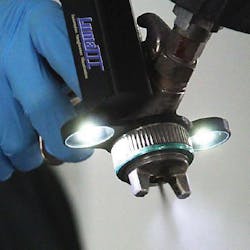According to Richard Waterhouse, the Aurora is a must-have tool in the paint booth. After the Luma team approached Mike’s Body Shop in Wichita, Kan.—the shop at which Waterhouse is the lead painter—about demoing the LED paint gun attachment from Luma III, Waterhouse said he was immediately sold on the product.
After the Luma III team approached Mike’s Auto Body in Wichita, Kan.—the shop at which Waterhouse is the lead painter—about demoing the Aurora LED paint gun attachment, Waterhouse said he was immediately sold on the product.
The attachment, made out of carbon fiber composites, fits behind the nozzle of a spray gun to provide a visual recognition of the center of a painter’s spray. The nozzle from the spray gun produces a faint shadow, allowing the painter to line up the shadow mark at the bottom of the previous pass to get a 50 percent overlap.
The Aurora operates at 4600 Kelvin, roughly equivalent to light from the sun hitting Earth at around noon. The LED light allows painters to color match during the painting process, rather than after.
“You can see the atomization, you can see your pattern a whole lot better, and you don’t have nearly the amount of shadows versus dark spots while painting because your light is right there in front of you,” Waterhouse says.
Waterhouse and shop manager Tyler Hutchinson purchased one light for each gun in the shop (primer, base and clear) and Hutchinson says the painters never go without the attachment now.
“You want to see what your paint product would look like naturally in the sun,” he says. “Sometimes it may look like you have a good coat coverage when you may not after taking it outside.”
THE RETURN:
Although the attachment isn’t expensive to begin with (it costs $299 per attachment), Hutchinson estimates it only takes one perfect paint job to recoup the cost.
“One paint job not being messed up would pay for itself,” he says. “If you figure in the costs of putting a car back in the paint booth and the man hours of just doing a fender, let’s say.”
Hutchinson says it has reduced the number of cars that need to be repainted in his shop significantly, and Waterhouse says it has also changed the way he paints.
“Some painters, like myself, like to spray wet on wet and do a 50/50 overlap,” he says. “I’ve had to change it closer to a 60/40 overlap because I see so much better.”
Interested in knowing the impact of a particular collision repair product in the shop? Send your suggestions to [email protected].



